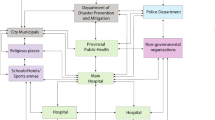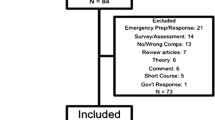Abstract
Due to their access to medically underserved and vulnerable populations, community health centers (CHCs) can play an essential role in emergency response. CHCs often fill this role in partnership with other local health resources, such as local health departments (LHD). Little research has been done to understand the success of these partnerships as it relates to emergency planning and emergency response. This study compares CHC and LHD personnel regarding past, present, and future collaborative preparedness and response activities. Surveys were distributed electronically to 1,265 clinical and clerical staff at LHDs and CHCs in 23 states who met the study criteria. Of the 522 respondents, 287 (55%) reported having engaged in collaborative preparedness activities in general, with CHCs more likely to report partnering than LHDs. LHDs were more likely than CHCs to report taking part in specific preparedness activities, such as planning activities (91, 79%), (χ2(1, N = 280) = 7.395, P < 0.05), mass dispensing drill/exercises (65, 42%), (χ2(1, N = 279) = 14.019, P < 0.001), and communication drill/exercises (69, 47%), (χ2(1, N = 280) = 13.059, P < 0.001). This study suggests that collaborations between CHCs and LHDs in general are occurring, but these general collaboration are not being translated into participation in functional drills or exercises. Additional efforts to ensure a more comprehensive partnership between CHCs and LHDs in emergency preparedness are warranted.

Similar content being viewed by others
References
US Department of Health and Human Services, Health Resources and Administration. (2009). Primary health care: The health center program. Retrieved June 1, 2009, from http://bphc.hrsa.gov/.
Kahan, E., Fogelman, Y., Kitai, E., & Vinker, S. (2003). Patient and family physician preferences for care and communication in the eventuality of anthrax terrorism. Family Practice, 20, 441–442.
Clawson, A., Menachemi, N., Beitsch, L., & Brooks, R. G. (2006). Are community health centers prepared for bioterrorism? Biosecurity and Bioterrorism: Biodefense Strategy, Practice and Science, 4, 55–63.
National Association of Community Health Centers, Inc. America’s Health Centers. (2009). Fact Sheet #0109. Retrieved May 20, 2009, from http://www.nachc.org/client/documents/America’s_Health_Centers_updated_3.09.pdf.
National Association of Community Health Centers, Inc. (2009). Community health centers: Meeting rural health needs. Fact sheet #1108. Retrieved May 20, 2009, from http://www.nachc.org/client/documents/Rural_Health_Fact_Sheet_Final1.pdf.
National Association of Community Health Centers, Inc. (2008). Serving patients with limited English proficiency: Results of a community health center survey. Retrieved May 20, 2009, from http://www.nachc.org/client/documents/LEP_report.pdf.
National Association of Community Health Centers, Inc. (2008). US Health Center fact sheet, 2008. Retrieved May 20, 2009, from http://www.nachc.com/client/documents/U.S._Fact_Sheet_2008.pdf.
Shin, P., Jones, K., & Rosenbaum, S. (2003). Reducing racial and ethnic disparities: Estimating the impact of high health center penetration in low-income communities. Washington, DC: Center for Health Services Research and Policy, George Washington University. Retrieved June 2, 2009, from http://www.gwumc.edu/sphhs/departments/healthpolicy/chsrp/downloads/GWU_Disparities_Report.pdf.
Forrest, C. B., & Whelan, E. M. (2000). Primary care safety-net delivery sites in the United States: A comparison of community health centers, hospital outpatient departments, and physicians’ offices. Journal of the American Medical Association, 284(16), 2077–2083.
Choudhry, L., Douglass, M., Lewis, J., Howard Olson, C., Osterman, R., & Shah, P. (2007). The impact of community health centers and community-affiliated health plans on emergency department use. Washington, DC: National Association of Community Health Centers.
Rust, G., Baltrus, P., Ye, J., et al. (2009). Presence of a community health center and uninsured emergency department visit rates in rural counties. Journal of Rural Health, 25(1), 8–16.
Association of State and Territorial Health Officials, National Association of Community Health Centers, National Association of County and City Health Officials, Inc. (2008). Collaborating with community health centers for preparedness. Retrieved June 2, 2009, from http://www.nachc.org/client/Collaborating_with_Community_Health_Centers_for_Preparedness.pdf.
Blumenshine, P. (2008). Pandemic influenza planning in the United States from a health disparities perspective. Emerging Infectious Diseases, 14(2), 710–711.
Wood, K. M. (2009). Community health centers: The untapped resource for public health and medical preparedness. Homeland Security Affairs, 5(1), 1–39.
Koh, H. K., Shei, A. C., Bataringaya, J., et al. (2006). Building community-based surge capacity through a public health and academic collaboration: The role of community health centers. Public Health Reports, 121(2), 211–216.
National Association of Community Health Centers, Inc. (2006). Legacy of a disaster: Health centers and hurricane Katrina one year later. Washington, DC: National Association of Community Health Centers.
Hamilton, D. R., Gavagan, T., Smart, K., et al. (2009). Houston’s medical disaster response to hurricane Katrina: Part 1: Transitioning from emergency evacuee care to community health care. Annals of Emergency Medicine, 53(4), 515–527. Epub 2009 January 10 available at: doi:10.1016/j.annemergmed.2008.10.024.
Hamilton, D. R., Gavagan, T., Smart, K., et al. (2009). Houston’s medical disaster response to hurricane Katrina: Part 2: Transitioning from emergency evacuee care to community health care. Annals of Emergency Medicine, 53(4), 515–527. Epub 2009 January 10 available at: doi:10.1016/j.annemergmed.2008.10.024.
Shi, L., & Collins, P. B. (2007). Public-private partnerships in community health centers: Addressing the needs of underserved populations. Organizational Ethics: Healthcare, Business and Policy, 4(1), 35–42.
Center for Disease Control and Prevention (CDC). (2003). Multistate outbreak of monkeypox—Illinois, Indiana, and Wisconsin, 2003. Morbidity and Mortality Weekly Report, 52(23), 537–540.
Subramanian, A., & McKinney, D. (2004). Ready or not? Two years after September 11th health centers work steadily to prepare for future disasters. National Association of Community Health Centers, Inc. Special Topics Issue Brief 4. Retrieved June 9, 2009, from http://www.nachc.com/client/documents/publications-resources/4.pdf.
Centers for Disease Control and Prevention (CDC). (1993). Outbreak of acute illness—Southwestern United States, 1993. Morbidity and Mortality Weekly Report, 42, 421–424.
Ablah, E., Tinius, A. M., Horn, L., Williams, C., & Gebbie, K. M. (2008). Community health centers and emergency preparedness: An assessment of competencies and training needs. Journal of Community Health, 33(4), 241–247.
Gebbie, K. M., Horn, L., McCollum, M., & O’Hara, K. (2009). Building a system for preparedness: The NYCEPCE NEST experience. Journal of Public Health Management and Practice, 15(2 Suppl), S3–S7.
Wineman, N. V., Braun, B. I., Barbera, J. A., & Loeb, J. M. (2007). Assessing the integration of health center and community emergency preparedness and response planning. Disaster Medicine and Public Health Preparedness, 1(2), 96–105.
National Association of County and City Health Officials. (2006). Emergency preparedness planning & response: Primary care and local health Departments. Fact sheet. Retrieved June 9, 2009, from http://www.naccho.org/publications/emergency/.
National Association of County and City Health Officials. (2004). Local public health agency-federally qualified health center collaboration to improve health service delivery. Issue Brief 4(1). Retrieved June 9, 2009, from http://archive.naccho.org/Documents/LPHA-CHC-Issue-Brief-4-13-04.pdf.
McKinney, D., Woods, R., & Keet, C. (2003). Preparing health centers for bioterrorism and other public health threats. National Association of Community Health Centers, Inc. Special Topics Issue Brief 1. Retrieved January 27, 2009, from http://www.nachc.com/client/documents/publications-resources/ib_1_03.pdf.
Harrison, S. (2008). Public health planning: Partnerships work. Domestic Preparedness Journal, 4(2), 2.
Bashir, Z., Hermann, J., Johnson, V. (2008). Indicators of Progress in Local Public Health Preparedness. National Association of County and City Health Officials. Research Brief. Retrieved January 29, 2009, from http://www.naccho.org/publications/emergency/.
Federal Funding for Public Health Emergency Preparedness: Implications and Ongoing Issues for Local Health Departments. (2007). National Association of County and City Health Officials. August. Retrieved January 29, 2009, from http://www.naccho.org/publications/emergency/.
Bureau of Primary Health Care. (2007). Program information notice 2007–16: Federal Tort Claims Act (FTCA) coverage for health center program grantees responding to emergencies. Washington, DC: US Dept of Health and Human Services.
Leifer, J., Zakheim, M., & Scott, M. (2005). Developing and implementing an emergency management plan for your health center. National Association of Community Health Centers, Inc. Risk Management Series Information Bulletin 11. Retrieved January 27, 2009, from http://www.nachc.com/client/documents/publications-resources/rm_11_05.pdf.
US Census Bureau. (2006). State and metropolitan area data book: 2006 (6th ed.). Washington, DC: US Govt. Printing Office.
Acknowledgments
The New York Consortium for Emergency Preparedness Continuing Education (NYCEPCE) program was funded by the Office of the Assistant Secretary for Preparedness and Response (ASPR), grant number 621889815.
Author information
Authors and Affiliations
Corresponding author
Rights and permissions
About this article
Cite this article
Ablah, E., Konda, K.S., Konda, K. et al. Emergency Preparedness Training and Response Among Community Health Centers and Local Health Departments: Results from a Multi-State Survey. J Community Health 35, 285–293 (2010). https://doi.org/10.1007/s10900-010-9236-7
Published:
Issue Date:
DOI: https://doi.org/10.1007/s10900-010-9236-7




